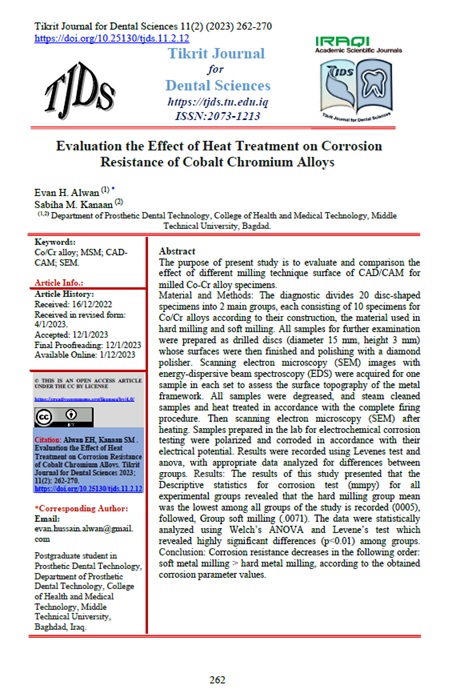Evaluation the Effect of Heat Treatment on Corrosion Resistance of Cobalt Chromium Alloys
Evan H. Alwan
Department of Prosthetic Dental Technology, College of Health and Medical Technology, Middle Technical University, Bagdad.
Sabiha M. Kanaan
Department of Prosthetic Dental Technology, College of Health and Medical Technology, Middle Technical University, Bagdad
DOI: https://doi.org/10.25130/tjds.11.2.12
Keywords: Co/Cr alloy, MSM, CAD-CAM, SEM
Abstract
The purpose of present study is to evaluate and comparison the effect of different milling technique surface of CAD/CAM for milled Co-Cr alloy specimens.
Material and Methods: The diagnostic divides 20 disc-shaped specimens into 2 main groups, each consisting of 10 specimens for Co/Cr alloys according to their construction, the material used in hard milling and soft milling. All samples for further examination were prepared as drilled discs (diameter 15 mm, height 3 mm) whose surfaces were then finished and polishing with a diamond polisher. Scanning electron microscopy (SEM) images with energy-dispersive beam spectroscopy (EDS) were acquired for one sample in each set to assess the surface topography of the metal framework. All samples were degreased, and steam cleaned samples and heat treated in accordance with the complete firing procedure. Then scanning electron microscopy (SEM) after heating. Samples prepared in the lab for electrochemical corrosion testing were polarized and corroded in accordance with their electrical potential. Results were recorded using Levenes test and anova, with appropriate data analyzed for differences between groups. Results: The results of this study presented that the Descriptive statistics for corrosion test (mmpy) for all experimental groups revealed that the hard milling group mean was the lowest among all groups of the study is recorded (0005), followed, Group soft milling (.0071). The data were statistically analyzed using Welch’s ANOVA and Levene’s test which revealed highly significant differences (p<0.01) among groups. Conclusion: Corrosion resistance decreases in the following order: soft metal milling > hard metal milling, according to the obtained corrosion parameter values.




